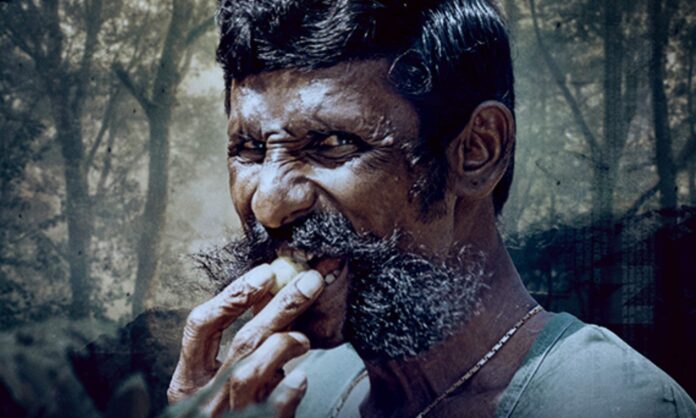Documentaries are an acquired taste. While some eagerly await and cherish non-fiction, your average movie-goer might prefer the elements that they are accustomed to in commercial cinema. It is easy for a documentary to stay true to its format if the makers are clear of the target audience. But what if they want their documentary to reach the widest demographic? The latest docuseries on the life of the notorious vigilante and anti-hero Koose Munisamy Veerappan (also titled the same), streaming on ZEE5, stitches together both fictional and non-fictional filmmaking styles to offer a ‘paisa vasool’ crash course on the well-documented yet surprisingly intriguing life of the protagonist.
Director: Sharath Jothi
Featuring: Veerappan, Nakheeran Gopal, Seeman, N Ram, Pa Pa Mohan, Subbu aka Subramanyan, Alexander IPS, Rohini, Jeeva Thangavel, Mohan Kumar, and Dhamayanthi
Streamer: ZEE5
Koose Munisamy Veerappan gives us both a first-person account as well as a bird’s eye view of the titular character and his fable. Brought to us by Nakkheeran Gopal, reportedly the first journalist who introduced Veerappan to the common man, the six-part docuseries has perspectives of historians, human rights activists, victims of Veerappan, his aides, witnesses, journalists, and of course… Veerappan himself.
Every episode of the series opens with a picturesque drone shot of a lush green forest, denoting the dominion of Veerappan and his gang. Initially, the shots set a scenic sense in our minds, a tranquil feeling. But as we go deeper and deeper into the story, a disturbing sense of darkness settles in, as we realise the depravity that the flora and fauna of the forest have witnessed. Our opinions are formed less from actual verbal clues and more from such visual metaphors.
The fictional-cum-non-fictional approach to the docuseries is a novel and successful attempt. While we hear accounts from sources, we are immediately shown a fictionalised version of how it might have played out. It’s even more captivating that the director Sharath Jothi chooses to go with the heavy strings of composer Satish Raghunathan to convey the essence of the scene, instead of elaborate dialogues. This works more so because any documentary is already infused with an overdose of information.
Every episode starts with a scene that hints at what is coming up in the next 45-odd minutes. At the middle or end of it, the scenes make a comeback, helping us get better clarity of the narrative. Another commendable aspect is the craft, be it editing or cinematography. For example, in a scene where Gurunathan, one of Veerappan’s aides is abducted by police officers in disguise, the entire segment plays out in the rear-view mirror of the car, which is a fascinating choice made by cinematographer Raj Kumar PM. Similarly, the editing focuses on juxtaposing contradictory yet compulsive facts, one after another. For instance, in the first episode, we find almost all of the sources calling Veerappan a criminal, a cheat and a gangster, which is followed by the intro card. Immediately after, we find Vidya Veerappan, daughter of the scourge recalling how villagers treated her warmly because they considered her father to be a hero. The attention to detail, and the need to tell a story that tells all sides, come to light in such small instances.
Coming to the narrative itself, Koose Munisamy Veerappan offers very few novel insights into the case. What makes it unprecedented is the first-hand oration from Veerappan himself. For those who only know of Veerappan in passing, the interview is salient as it provides a sense of authenticity. It leaves the ball in the viewers’ court to decide what they feel about him. In fact, a young Vidya first saw her father through one such video interview, and even she says she cannot recollect what he said back then.
The series neither tries to justify nor villainise Veerappan. It attempts to show us who he really was through various means. An entire episode trails the police brutality people faced as they were caught between Veerappan and the uniformed officers. And as we try to reel away from the horrors, we may, for a second, want to defend Veerappan’s ideologies. But the series is quick to add a shot of him boasting with a laugh, saying, “I shot the DFO, slaughtered his head, set it ablaze, and left it on the Yerkayam hills so he could repent for his sins.”
Albeit somewhere, we feel like Nakheeran Gopal has his agenda hidden here and there. Early on, he says, “We should not call a murderer like him a Veerar (brave one), but he is a veerar.” We later find him, along with the accounts of Veerappan, calling out the government during the time for not taking action against police brutality. However, the names of the alleged criminal police officers he mentions are beeped. A journalist’s duty is to report facts as is. But it is an open secret that most journalists somehow try to suffuse their perspectives into their reportage. For someone who knows nothing about the chronicle at hand, this recital could cloud their judgment. Another negative is perhaps the slow pace of the docuseries, which is understandable but still the lack of urgency is disconcerting at times.
For someone who knows nothing about the eponymous Koose Munisamy Veerappan, this docuseries is an exhaustive lesson, and for others, it is a detailed brush-up of what they already know. The series, at large, is seemingly unbiased. There’s a whole second season waiting, which will cover actor Rajkumar’s abduction, negotiations with the government, and Veerappan’s end. Until the second season arrives, I will be thinking about Veerappan, just like the poignant Velu Naicker who tearfully says “Therilaye paa” when his grandson asks, “Neenga nallavara kettavara?” What I will be sure of, is that the grass is definitely not greener on the other side…
#paisavasool #crash #tale #notori #Cinema #express

